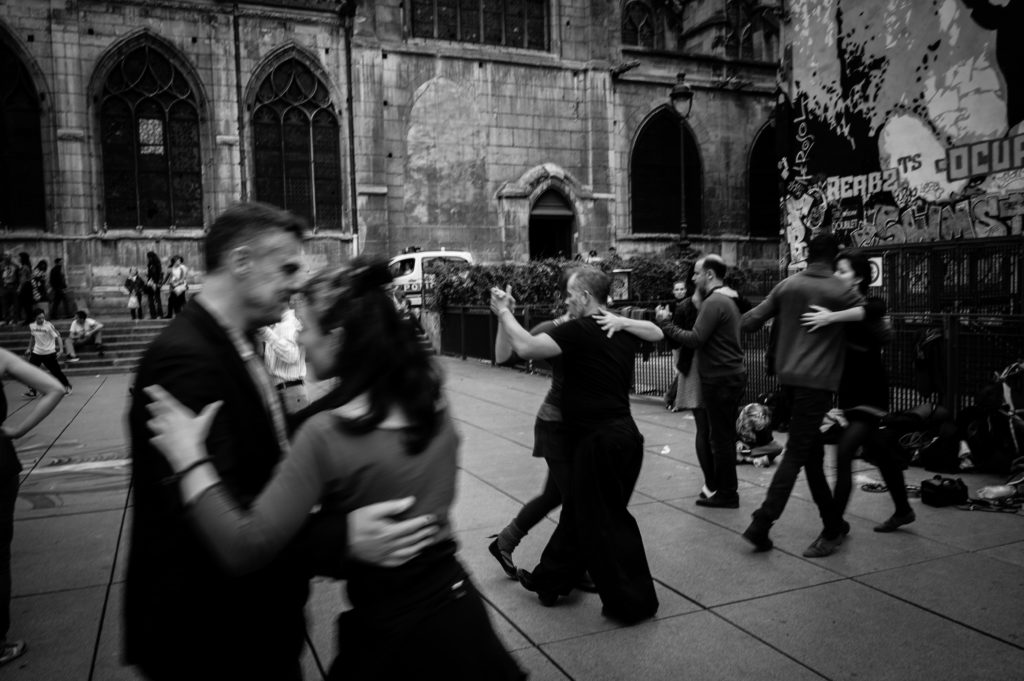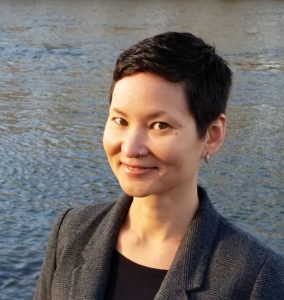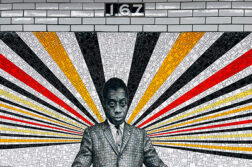
I HADN’T BEEN in a church in decades, and was wary about stepping foot in one that night, despite the line of people waiting to shake my hand, despite the tattooed woman pointing me to a table lined with name tags, cookies, and pitchers of water. The church doors were open, letting in an early autumn breeze, and I considered ducking back out. Before I could, though, someone waved me toward the sanctuary, where the pews had been pushed aside to form a dance floor.
I had heard about the Rosetown Ramblers from a LGBT group at work and had gone to this first lesson alone, on a lark. I hadn’t square danced since elementary school and didn’t remember anything about it, except that it was one of the few times in my youth that I had loved gym class. Before torturous games like dodgeball and “smear the queer,” before competitive team sports where I was uniformly last to be picked, square dancing had been proof that physical activity could be carefree. It was this hazy memory—of a time when twirling was socially acceptable regardless of the participants’ genders, when dancing was gleeful no matter how haphazardly we performed the steps—that led me to try out a queer square-dancing club.
Held in a church that was home to a friendly, LGBT-affirming congregation, the Ramblers’ lessons began with a question that might have proved daunting in another environment: Boy or Girl? Despite being nonbinary, I almost always default to “girl” when these are the only two options presented, a defensive habit meant to put other people at ease, but the other dancers made it clear my answer would in no way reflect on my gender.
“Really,” one dancer told me, “It’s just easier to learn if you choose one position and stick with it for a while. No one cares if you dance boy or dance girl.” Looking around, it was true: Dancers of various genders were calling out “I need a boy” or “I need a girl” to find a partner, and people of all genders arrived to fill those gaps.
“Boy,” I said.
“Great,” a tall man replied, taking me by the hand. “I’ll dance girl with you.” We formed a square with three other couples, and the caller introduced us to half a dozen calls before the night’s end. I made many mistakes, but the experienced dancers—or “angels,” in square dance parlance—redirected me, even when I ended up facing the wrong way or wandering off from the square. They did this with everyone, an act of generosity meant to emphasize that in this club, the goal wasn’t to get it right, but to have a good time.
This magnanimous spirit kept me returning every Wednesday night. We danced to Donna Summer, Pat Benatar, and Peggy Lee. Some couples danced in dapper matching outfits, but most of us arrived solo in our work clothes: sweaters and slacks, dresses and boots, t-shirts and jeans, hospital scrubs. I danced with various partners, often trading them between each “tip,” or round of dancing. I paired with people who had been square dancing since I was a child and who stayed behind after each tip to show me the intricacies of a particular call or an easier way to remember a step. I paired with people a quarter of my age, who managed to spin me beneath their ten-year-old arms. I got to know the other dancers, who were queer themselves or the parents or friends of LGBT folks, or who just wanted to square dance without having to abide by the generally stricter dress codes and gender roles of straight clubs.
As the calls became more familiar, I started catching on to “fluff,” the stylized gestures and sounds with which dancers respond to particular calls. I loved the flair and humor of the fluff, its over-the-top mocking of gender conventions. The caller would announce Scoot Back, and the person scooting would, if dancing girl, place a hand to their brow and sigh, mimicking a fainting spell. If dancing boy, the scooter would grunt and flex. Or the caller would tell us to Spin the Top, and the whole club would shout “He’s no top!” or “Spank the bottom!” or one of the other endless variants associated with that call. We did this all while turning in different directions, dropping and picking up other dancers’ hands, shifting from one part of the square to another.
By the spring, I had graduated to angel myself, and that Fall, began learning the girl position. I aspired to be “bidansual,” a status that only a few dancers in the club held, and one that meant I could be a partner to any dancer who needed one. I had just become confident enough to switch from boy to girl and back again with each tip when COVID-19 hit, and the club went on what the club president, Jeff, calls a Ramblers Respite. We haven’t been able to dance, as the calls require touching and proximity, but Jeff has kept our community together, hosting socially distanced walks and the occasional Zoom call so we can catch up.
I miss dancing with the Ramblers. I miss the high energy and higher camp. I miss the mental focus required to listen to the calls, to be aware of my body, and to remain attentive to my partner and the other members of my square. I miss how it felt like a moving meditation, an orderly sequence: a square reforming as a line, a line bending to face a different direction, a step back to make a square again.
One day, we’ll be able to gather together again to flutterwheel—to courtesy turn, to rollaway with a half sashay. I’ve forgotten so much since the pandemic started that I’m looking forward to starting lessons all over again, to practicing the art of how to dance boy, how to dance girl.
 Jennifer (JP) Perrine (they/themme) is a queer, multiracial Asian American writer and educator living in Portland, Oregon. JP is the author of four books of poetry—Again, In the Human Zoo, The Body Is No Machine, and No Confession, No Mass—and also writes short fiction and essays. Learn more at www.jenniferperrine.org.
Jennifer (JP) Perrine (they/themme) is a queer, multiracial Asian American writer and educator living in Portland, Oregon. JP is the author of four books of poetry—Again, In the Human Zoo, The Body Is No Machine, and No Confession, No Mass—and also writes short fiction and essays. Learn more at www.jenniferperrine.org.





